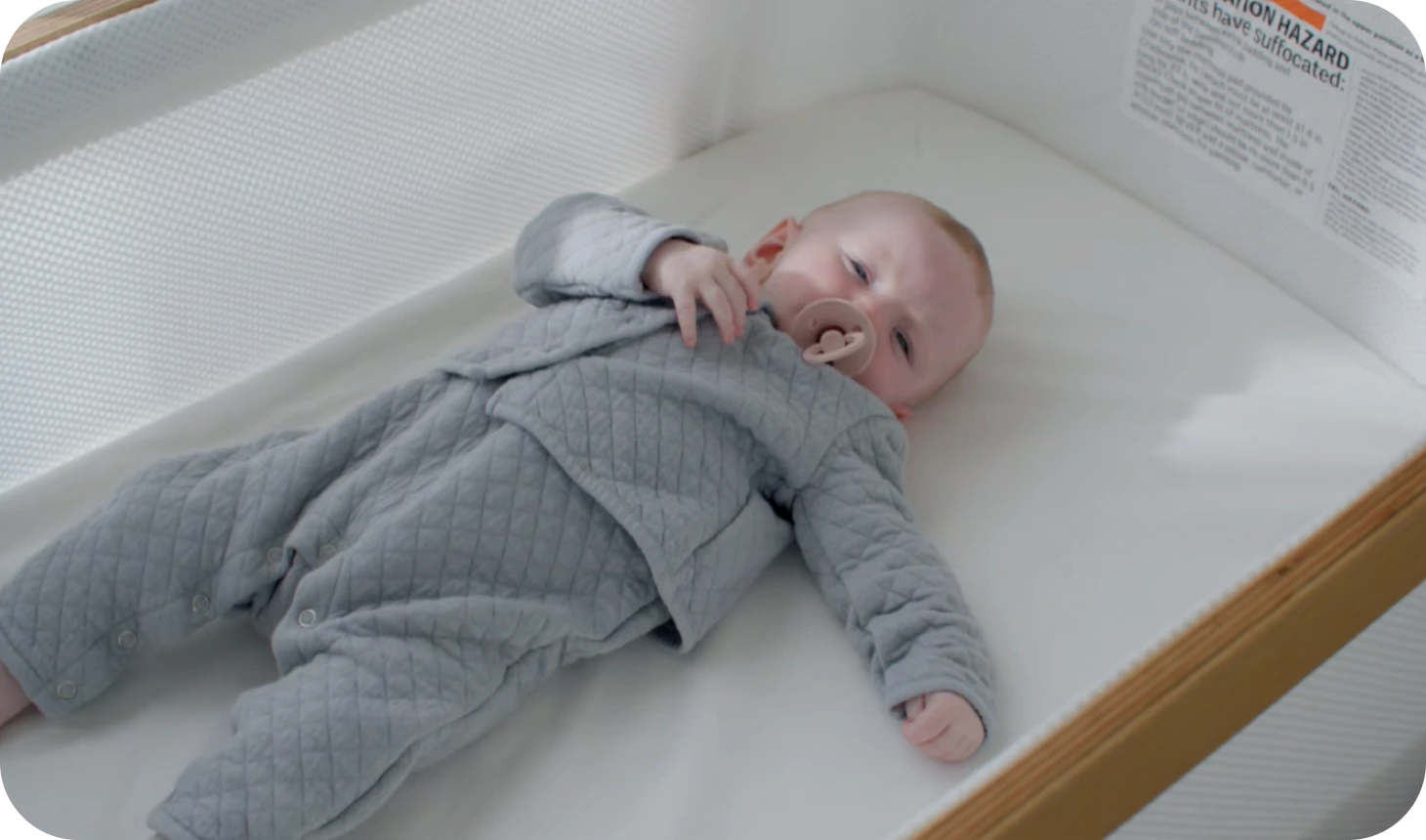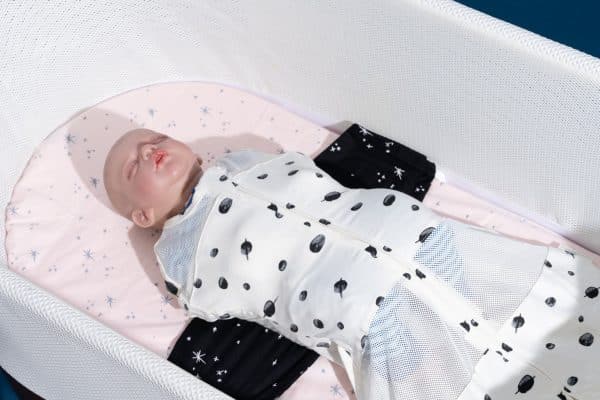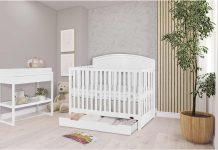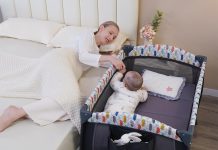Have you ever wondered how smart cribs can track your baby’s sleep patterns? These innovative devices are equipped with advanced technology that allows them to monitor your baby’s sleep and provide valuable insights. From detecting movement and sound to analyzing sleep cycles, smart cribs offer parents a deeper understanding of their baby’s sleep habits. So, let’s explore the fascinating world of smart cribs and discover how they can revolutionize parenting.
This image is property of s.yimg.com.
Review contents
1. Sensor Technology in Smart Cribs
Smart cribs utilize advanced sensor technology to track and monitor your baby’s sleep patterns. These sensors play a crucial role in collecting data about your baby’s movements, audio cues, and the surrounding environment. Understanding the types of sensors used, their position and placement, as well as the data collection and processing methods, can give you a comprehensive understanding of how smart cribs work.
1.1 Types of Sensors Used
Smart cribs incorporate various types of sensors to capture different aspects of your baby’s sleep. These sensors may include:
- Motion sensors: These sensors detect your baby’s movements and can provide valuable insights into their sleep patterns, including how often they toss and turn or change positions during the night.
- Sound sensors: Sound sensors enable audio monitoring, allowing you to hear your baby’s sounds and identify if they are waking up or experiencing any discomfort during sleep.
- Environmental sensors: These sensors measure factors such as temperature, humidity, and air quality, providing you with an understanding of the conditions in your baby’s sleep environment.
1.2 Position and Placement of Sensors
To ensure accurate data collection, the sensors in smart cribs are strategically positioned and placed within the crib. Motion sensors are typically located underneath the mattress or in the corners of the crib to track movement. Sound sensors are often integrated into the crib’s panel to capture audio without obstructing the baby’s comfort. Environmental sensors may be discreetly placed in the crib’s structure or integrated into the crib’s control unit.
1.3 Data Collection and Processing
Once the sensors in the smart crib collect the necessary data, it is processed and analyzed to provide meaningful insights about your baby’s sleep patterns. This data is typically transmitted wirelessly to a base station or a smartphone application for further analysis. The data collection and processing algorithms are designed to filter out irrelevant or noisy information, ensuring accurate and reliable sleep data.
2. Sleep Monitoring Features
Smart cribs offer an array of sleep monitoring features that give parents a comprehensive understanding of their baby’s sleep quality and patterns. These features include movement detection, audio monitoring, and environmental monitoring.
2.1 Movement Detection
The movement detection feature is one of the core functions of a smart crib. It utilizes motion sensors to track your baby’s movements during sleep. By monitoring your baby’s movements throughout the night, you can gain valuable insights into their sleep patterns. This feature can indicate restlessness, frequent awakenings, or even sudden movements that could potentially disturb their sleep.
2.2 Audio Monitoring
Audio monitoring allows you to listen to your baby’s sounds and determine if they are waking up or experiencing any discomfort during sleep. Sound sensors integrated into the smart crib’s panel capture the audio cues, providing you with real-time updates. This feature can be especially helpful for parents who want to ensure their baby’s comfort and respond promptly to their needs.
2.3 Environmental Monitoring
Smart cribs also offer environmental monitoring capabilities, including temperature, humidity, and air quality sensors. These sensors ensure that your baby’s sleep environment is conducive to a comfortable and safe night’s rest. By monitoring these factors, you can make informed decisions regarding room temperature adjustments, proper ventilation, or additional environmental modifications that may enhance your baby’s sleep quality.
3. Sleep Data Analysis
After collecting data through the sensors, smart cribs employ sophisticated algorithms to analyze and interpret the sleep data. This analysis provides essential metrics such as sleep duration, sleep quality, and sleep patterns.
3.1 Sleep Duration
One of the primary metrics measured by smart cribs is sleep duration, which refers to the total amount of time your baby spends sleeping. By tracking the duration of your baby’s sleep, you can ensure that they are getting enough rest and adjust their sleep schedules accordingly.
3.2 Sleep Quality
Sleep quality is another vital aspect of sleep data analysis. Smart cribs assess sleep quality by analyzing various factors, such as the number of awakenings, movements, and how long it takes for your baby to fall asleep. This insight into sleep quality can help identify potential sleep disturbances or discomfort that may affect your baby’s overall sleep experience.
3.3 Sleep Patterns
Smart cribs can also provide valuable information about your baby’s sleep patterns. By analyzing the collected data, they can determine if your baby follows consistent sleep patterns, such as regular bedtimes and wake-up times. Understanding your baby’s sleep patterns can assist in establishing a healthy sleep routine and identifying any irregularities that may require attention.
4. Sleep Pattern Visualization and Insights
Smart cribs often offer graphical representations of the sleep data, allowing parents to visualize their baby’s sleep patterns easily. These visualizations enable you to gain a clear understanding of your baby’s sleep trends, making it easier to identify any potential issues or improvements.
4.1 Graphical Representation of Sleep Data
The graphical representation of sleep data offers a holistic view of your baby’s sleep patterns over time. It may display sleep duration, quality, and patterns in a clear and easy-to-understand format, such as line graphs or bar charts. This visual representation allows you to monitor trends, compare sleep patterns over different days, and track progress as you implement sleep training techniques.
4.2 Sleep Stage Analysis
Advanced smart cribs may provide sleep stage analysis, which divides sleep into different stages such as light sleep, deep sleep, and REM (rapid eye movement) sleep. By understanding the distribution of sleep stages, parents can gain insights into their baby’s sleep cycles and optimize sleep schedules accordingly. This feature can be particularly beneficial for parents who want to fine-tune their baby’s sleep routine.
4.3 Sleep Recommendations
Based on the sleep data and patterns, smart cribs can also offer personalized sleep recommendations. These recommendations may include suggestions for adjusting sleep schedules, optimizing sleep environments, or implementing sleep training techniques. By providing tailored guidance, smart cribs empower parents to make informed decisions and promote healthier sleep habits for their babies.
This image is property of assets.cradlewise.com.
5. Connectivity and Mobile Applications
Smart cribs are designed to seamlessly connect with other devices and mobile applications, making it convenient for parents to access and monitor sleep data.
5.1 Wireless Connectivity Options
Smart cribs often feature wireless connectivity options, such as Bluetooth or Wi-Fi, allowing the crib to connect with a designated base station or mobile application. This wireless connection enables real-time data transmission, ensuring that parents have access to accurate and up-to-date sleep information.
5.2 Smartphone Integration
Mobile applications play a significant role in the functionality of smart cribs. These applications allow parents to remotely monitor their baby’s sleep data, receive notifications, and access additional features. Smartphone integration enhances convenience and accessibility, allowing parents to keep track of their baby’s sleep patterns from anywhere at any time.
5.3 Alerts and Notifications
Smart cribs can send alerts and notifications to parents’ smartphones to keep them informed about their baby’s sleep activities. These alerts may include notifications for when the baby wakes up, experiences significant movements, or if any environmental factors, such as temperature or air quality, require attention. This feature helps parents stay connected and provides reassurance that their baby’s sleep is being monitored effectively.
6. Privacy and Security Concerns
While the benefits of smart cribs are undeniable, it is crucial to address privacy and security concerns associated with these advanced technologies.
6.1 Data Privacy Measures
Smart crib manufacturers prioritize data privacy and employ measures to protect the sensitive sleep data collected. They often implement strict privacy policies that outline how data is stored, used, and shared. It is advisable to research and choose a smart crib manufacturer that is committed to protecting your baby’s sleep data privacy.
6.2 Encryption and Security Protocols
To ensure the security of sleep data during transmission and storage, smart cribs utilize encryption and security protocols. These measures prevent unauthorized access and safeguard the data against potential breaches. Prioritizing a smart crib with robust encryption and security features is essential in maintaining the privacy and protection of your baby’s sleep information.
6.3 User Consent and Control
Smart cribs should always prioritize user consent and control over sleep data. Parents should have the ability to grant or revoke permissions for data collection and transmission. It is essential to review and understand the privacy settings and controls available within the smart crib’s mobile application to ensure you are comfortable with how your baby’s sleep data is being handled.
This image is property of i.insider.com.
7. Impact on Parenting and Sleep Training
Smart cribs have a significant impact on parenting and sleep training, offering invaluable features that assist parents in understanding and improving their baby’s sleep experience.
7.1 Real-Time Monitoring
Real-time monitoring capabilities provide parents with peace of mind, allowing them to keep a close eye on their baby’s sleep activities. The ability to remotely access sleep data and receive immediate alerts ensures that parents can respond promptly to their baby’s needs. Real-time monitoring fosters a sense of security, knowing that you are connected to your baby’s sleep journey at all times.
7.2 Insights and Recommendations for Sleep Training
Smart cribs provide valuable insights and recommendations to facilitate sleep training techniques. By analyzing sleep data and patterns, parents can identify potential areas for improvement and adjust sleep schedules accordingly. Smart cribs empower parents with data-driven guidance, making the sleep training process more effective and efficient.
7.3 Parental Peace of Mind
Perhaps one of the most significant benefits of smart cribs is the peace of mind they offer to parents. By providing access to accurate sleep data, real-time monitoring, and personalized recommendations, smart cribs enable parents to make informed decisions regarding their baby’s sleep. This peace of mind contributes to a healthier and happier parenting experience, knowing that you have the necessary tools to support your baby’s sleep journey.
8. Comparison with Traditional Monitoring Methods
It is essential to consider the advantages and limitations of smart cribs compared to traditional monitoring methods to assess their efficacy and suitability for your specific needs.
8.1 Advantages of Smart Cribs
Smart cribs offer several advantages over traditional monitoring methods. They provide real-time monitoring, detailed sleep pattern analysis, and personalized sleep recommendations. Smart cribs also offer convenience through wireless connectivity and mobile applications, allowing parents to monitor sleep data remotely. The comprehensive insights and features provided by smart cribs enhance the accuracy and effectiveness of sleep monitoring and training.
8.2 Limitations and Considerations
While smart cribs offer numerous benefits, it is crucial to consider their limitations and potential considerations. Smart cribs require a reliable wireless connection and depend on the functionality of mobile applications. Additionally, smart cribs come at a higher cost compared to traditional cribs and may require ongoing subscription fees for premium features or data storage. Parents should also familiarize themselves with the setup and operation procedures of smart cribs to ensure optimal performance.
This image is property of s.yimg.com.
9. Smart Crib Market Trends and Future Developments
Smart cribs are part of an ever-evolving market that continues to embrace innovation and advanced technologies. Understanding the current market landscape, growth potential, and emerging technologies can provide insights into the future of smart cribs.
9.1 Current Market Landscape
The smart crib market is experiencing significant growth, with numerous manufacturers developing innovative products to meet the demands of modern parents. High-tech features, improved sensor technology, and enhanced connectivity options are becoming the norm in smart cribs. Multiple options are available in terms of features, design, and price range, allowing parents to choose a smart crib that suits their specific preferences and budget.
9.2 Growth Potential and Forecast
The growth potential of the smart crib market is promising, driven by the increasing demand for innovative baby care products. As parents become more tech-savvy and seek advanced solutions for their baby’s sleep, smart cribs are expected to become a staple in nurseries worldwide. With ongoing advancements in sensor technology, data analysis algorithms, and mobile applications, the future of smart cribs looks bright.
9.3 Emerging Technologies in Smart Cribs
The future of smart cribs holds exciting possibilities as emerging technologies continue to revolutionize the baby care industry. Some potential developments include expanded sleep pattern analysis capabilities, integration with other smart home devices, and improved user interfaces for seamless interaction. As technology continues to evolve, smart cribs will likely become more sophisticated, empowering parents with even deeper insights into their baby’s sleep patterns and optimizing their overall sleep experience.
10. Conclusion
Smart cribs have revolutionized the way parents can monitor and understand their baby’s sleep patterns. Through advanced sensor technology, sleep monitoring features, data analysis, and visualization, smart cribs provide invaluable insights and recommendations for optimal sleep training and parenting. With wireless connectivity options, mobile applications, and real-time monitoring capabilities, smart cribs offer convenience and peace of mind to parents. While privacy and security concerns should be considered, the advantages of smart cribs over traditional monitoring methods make them a compelling choice for modern parents seeking to enhance their baby’s sleep experience. As the smart crib market continues to grow and evolve, the future holds exciting possibilities for further advancements and innovations, ultimately benefiting both parents and babies in their sleep journeys.
This image is property of cdn.thewirecutter.com.
































